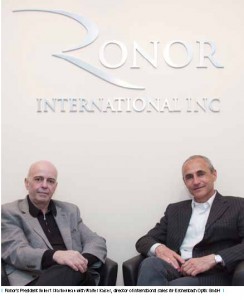By Paddy Kamen
 Silmo President Philippe Lafont took time to speak with Envision: seeing beyond magazine about the upcoming show and how his team is responding to new ways of doing business. Here is our interview:
Silmo President Philippe Lafont took time to speak with Envision: seeing beyond magazine about the upcoming show and how his team is responding to new ways of doing business. Here is our interview:
ESB: What changes have you made for 2014 and how will they improve the experience of exhibitors and visitors?
Philippe Lafont: Every year, we make adjustments to the exhibition, some of them minor but others more substantial and highly visible. Our goal is to respond to market changes and meet both exhibitors’ and visitors’ expectations. Our thinking, for this and for future editions, is to simplify the visitor pathway, the “customer experience” by reconfiguring the exhibition’s offering using a more refined segmentation. We believe there is a need to showcase dynamic growth sectors such as sport, luxury goods and new technologies. This segmentation is also a major commercial strategy for exhibitors seeking greater visibility, a guaranteed means of meeting the buyers and opticians attending the four-day exhibition.
ESB: The optical trade show world is becoming more competitive at the same time as the economic realities are sobering. What is Silmo doing this year to improve its competitive edge with exhibitors and visitors? In what ways is Silmo ahead of the competition?
PL: It is true that in a still uncertain economic climate, companies are seeking to optimise, or even reduce their investment in trade shows. We need to integrate this into our own sales strategy by offering solutions tailored to this specific context. For example, companies may not necessarily wish to exhibit at an individual booth, but rather in a showroom setting. Our role is to be open and creative, which will enable us to provide the most wide-ranging and comprehensive offering possible within a flexible exhibition package. Our competitive advantages lie in a desire not to set the event in stone, but rather to shape its development by prioritizing innovation… and above all by remembering that we are much more than just a commercial exhibition rolled out once a year; we are also a forum for debate, knowledge, discovery and promotion of the optics and eyewear sector throughout the entire year.
ESB: Would you agree that the role of the trade show is being rapidly redefined by changes in communications technology? If so, how does Silmo respond to that?
PL: Several years ago, people were talking of the decline or even demise of the trade fair format, but in fact the very opposite has happened – there have never been so many events taking place across the world! The virtual world has crossed over into the real world, placing people at the heart of the agenda. The opening up of new markets globally cannot be achieved from a distance; it relies on meeting stakeholders in person. The more the business environment expands, the greater the need to maximize its presence across every continent. As far as Silmo is concerned, it has long been an active member of the digital community, with a vocal presence in every social media outlet, an interactive website packed with information, and a digital trends magazine (Mo by Silmo).
ESB: The 2014 edition of Silmo – from September 26 to 29, 2014 – in Paris, promises to be a stimulating and educational forum for everyone in the optical industry.



